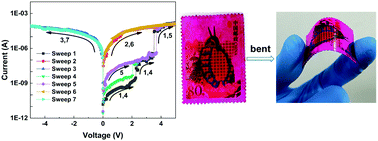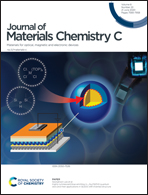Conjugated zwitterion-inspired flexible ternary resistive memory from rhodamine dyes†
Abstract
As one of the candidates for the next generation of data storage techniques, organic multilevel resistive memory has attracted more and more attention. Even though many types of materials have been fabricated into memory devices and successfully obtained multilevel memory behaviors, they still suffer from complex fabrication processes, relatively expensive price and poor temperature stability, which hinders the further applications of RRAM techniques. On the other hand, many organics dyes with a conjugated zwitterion structure are commercially available and inexpensive but rarely considered as memory materials. Herein, two commercial dyes, Rhodamine B (Rh B) and Rhodamine 6G (R 6G), were selected as active materials to fabricate memory devices through a one-step method. The as-fabricated memory devices showed ternary write-once-read-many-times (WORM) type memory behaviors, with the retention time up to 5000 s. Benefitted from the strong intermolecular interactions, rhodamine-based memory devices could work stably under 80 °C. Additionally, Rh B and R 6G could also be fabricated on various flexible substrates, such as polyethylene terephthalate (PET), stamps and tree leaves. The ternary memory behaviors could be sustained after bending 1000 times. Our work demonstrates the potential of commercially available dyes for low price and easy-fabrication flexible multilevel resistive memories.



 Please wait while we load your content...
Please wait while we load your content...